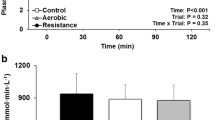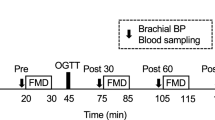Abstract
The cardiovascular (CV) responses to meal ingestion and orthostasis are well established. The effect of meal ingestion and meal composition on the CV responses to orthostasis are unknown. The effect of high carbohydrate (HC) and high fat (HF) meal ingestion on the CV responses to simulated orthostatic stress (using graded lower body subatmospheric pressure (LBSP)) was assessed in nine healthy young volunteers. Cardiac output (CO), forearm blood flow (FABF) heart rate (HR) and blood pressure (BP) were measured before and during LBSP while fasted and after eating HC and HF meals. Ingestion of both meals led to an increase in CO and HR. Both meals resulted in a fall in total peripheral resistance but only HC led to a significant fall in BP (p<0.05). HF had no effect on the CV responses to LBSP, whereas HC resulted in attenuated FABF and forearm vascular resistance responses (p<0.05). Thus, ingestion of an HC meal significantly attenuates the forearm vascular response to orthostatic stress and the hypotensive effect of orthostasis is additive to that occurring after an HC meal.
Similar content being viewed by others
References
Blomqvist CG, Stone HL. Cardiovascular adjustments to gravitational stress. In: Shepherd JT, Abboud FM, eds.Handbook of Physiology, Section 2, The cardiovascular system. Washington: American Physiological Society, 1984; 1025–1063.
Collins KJ, Exton-Smith AN, James MH, Oliver DJ. Functional changes in autonomic nervous responses with ageing.Age and Ageing 1980;9: 17–24.
Kelbaek HO, Munck O, Christensen NJ, Godtfredsen J. Central haemodynamic changes after a meal.Br Heart J 1989;61: 506–509.
Sidery MB, Macdonald IA, Cowley AJ, Fullwood LJ. Cardiovascular responses to high-fat and high-carbohydrate meals in young subjects.Am J Physiol 1991;261: H1430-H1436.
Heseltine D, Potter JF, Hartley IA, Macdonald IA, James OFW. Blood pressure, heart rate and neuroendocrine responses to a high carbohydrate and a high fat meal in healthy young subjects.Clin Sci Lond 1990;79: 517–522.
Ryan SM, Goldberger AL, Ruthazen L, Mietus J, Lipsitz LA. Spectral analysis of heart rate dynamics in elderly persons with postprandial hypotension.Am J Cardiol 1992;69: 201–205.
Hayano JY, Sakakibara M, Yamada T, et al. Diurnal variations in vagal and sympathetic cardiac control.Am J Physiol 1990;258: H642–646.
Wolthius RA, Bergman SA, Nicogossian AE. Physiological effects of locally applied reduced pressure in man.Physiol Rev 1974;54: 566–599.
Potter JF, Heseltine D, Hartley G, Matthews J, Macdonald IA, James OFW. Effects of meal composition on the postprandial blood pressure, catecholamine and insulin changes in elderly subjects.Clin Sci Lond 1989;77: 265–272.
Huntsman LL, Stewart DK, Barnes SR, Franklin SB, Colocousis JS, Hessel EA. Non-invasive Doppler determination of cardiac output in man: clinical validation.Circulation 1983;67: 593–602.
Loeppky JA, Hoekenga DE, Greene ER, Luft UC. Comparison of non-invasive pulsed Doppler and Fick measurements of stroke volume in cardiac patients.Am Heart J 1984;107: 339–346.
Coats AJS. Doppler ultrasonic measurement of cardiac output: reproducibility and validation.Eur Heart J 1990;11: 49–61.
Greenfield AD, Whitney RJ, Mowbray JF. Methods for the investigation of preripheral blood flow.Br Med Bull 1963;19: 101–109.
Whitney RJ. Measurement of volume changes in human limbs.J Physiol Lond 1953;121: 1–27.
Sidery MB, Cowley AJ, Macdonald IA. Cardiovascular responses to a high fat and a high carbohydrate meal in healthy elderly subjects.Clin Sci Lond 1993;84: 263–270.
Buck J, Haigh JR, Birmingham AT, Macdonald IA. Effect of food intake on orthostatic tolerance and finger tremor in healthy young subjects.Proc Nut Soc Lond 1989;48: 134A.
Scott AR, Bennett T, Macdonald IA. Effects of hyperinsulinaemia on the cardiovascular responses to graded hypovolaemia in normal subjects.Clin Sci Lond 1988;75: 85–92.
Zoller R, Mark AL, Abboud FM, Schmid P, Heistad D. The role of low pressure baroreceptors in reflex vasoconstrictor responses in man.J Clin Invest 1972;51: 2967–2972.
Grassi GC, Giannattasio A, Saino E, et al. Cardiopulmonary receptor modulation of plasma renin activity in normotensive and hypertensive subjects.Hypertension 1988;11: 92–99.
Mohanty PK, Thames MD, Arrowood JA, Sowers JR, McNamara C, Szentpetery S. Impairment of cardiopulmonary baroreflex after cardiac transplantation in humans.Circulation 1987;75: 914–921.
Abboud FM, Eckberg DL, Johannsen JU, Mark AL. Carotid and cardiopulmonary baroreceptor control of splanchnic and foream vascular resistance during venous pooling in man.J Physiol 1979;286: 173–184.
Schobel HP, Oren RM, Mark AL, Ferguson DW: Influence of resting sympathetic activity on reflex sympathetic responses in normal man.Clin Aut Res 1995;5: 71–80.
Wallin BG, Fagius J. Peripheral sympathetic nervous activity in conscious humans.Ann Rev Physiol 1988;50: 565–576.
Berne C, Fagius J, Niklasson F. Sympathetic response to oral carbohydrate administration.J Clin Invest 1989;84: 1403–1409.
Rowe JW, Young JB, Minaker KL, Stevens AL, Pallotta J, Landsberg L. Effects of insulin and glucose infusions on sympathetic nervous system activity in normal man.Diabetes 1981;30: 219–225.
Muntzel M, Morgan DA, Mark AL, Johnson AK. Intracerebroventricular insulin produces nonuniform increases in sympathetic nerve activity.Am J Physiol 1994;267: R1350-R1355.
Anderson EA, Hoffman RP, Balon TW, Sinkey CA, Mark AL. Hyperinsulinaemia produces both sympathetic neural activation and vasodilation in normal humans.J Clin Invest 1991;87: 2246–2252.
Laakso M, Edelman SV, Bretchel G, Baron AD. Decreased effect of insulin to stimulate skeletal muscle blood flow in obese man: a novel mechanism for insulin resistance.J Clin Invest 1990;85: 1844–1852.
Laakso M, Edelman SV, Bretchel G, Baron AD. Impaired insulinmediated skeletal muscle blood flow in patients with NIDDM.Diabetes 1992;41: 1076–1083.
Baron A, Bretchel G, Johnson A, Fineberg N, Henry DP, Steinberg HO. Interactions between insulin and norepinephrine on blood pressure and insulin sensitivity. Studies in lean and obese men.J Clin Invest 1994;93: 2453–2462.
Tidgren BE, Hjemdahl E, Theodorsson E, Nussberger J. Renal responses to lower body negative pressure in humans.Am J Physiol 1990;259: F573-F579.
Taylor JA, Halliwill JR, Brown TE, Hayano J, Eckberg DL. Non hypotensive hypovolaemia reduces ascending aortic dimensions in humans.J Physiol London 1995;483: 289–298.
Stewart WJ, Jiang L, Mich R, Pandian N, Guerrero JL, Weyman AE. Vanable effects of changes in flow rate through aortic, pulmonary and mitral valves on valve area and flow velocity: impact on quantitative Doppler flow calculations.J Am Coll Cardiol 1985;6: 653–662.
Murray RH, Thompson LJ, Bowers JA, Albright CP, Hemodynamic effects of graded hypovolaemia and vasodepressor syncope induced by lower body negative pressure.Am Heart J 1968;76: 799–811.
Sneddon JF, Counihan PJ, Bashir Y, Haywood GJ, Ward DE, Camm AJ. Impaired immediate vasoconstrictor responses in patients with recurrent neurally mediated syncope.Am J Cardiol 1993;71: 72–76.
Author information
Authors and Affiliations
Rights and permissions
About this article
Cite this article
Kearney, M.T., Stubbs, T.A., Cowley, A.J. et al. A carbohydrate meal attenuates the forearm vasoconstrictor response to lower body subatmospheric pressure in healthy young adults. Clinical Autonomic Research 7, 285–291 (1997). https://doi.org/10.1007/BF02267719
Received:
Accepted:
Issue Date:
DOI: https://doi.org/10.1007/BF02267719




